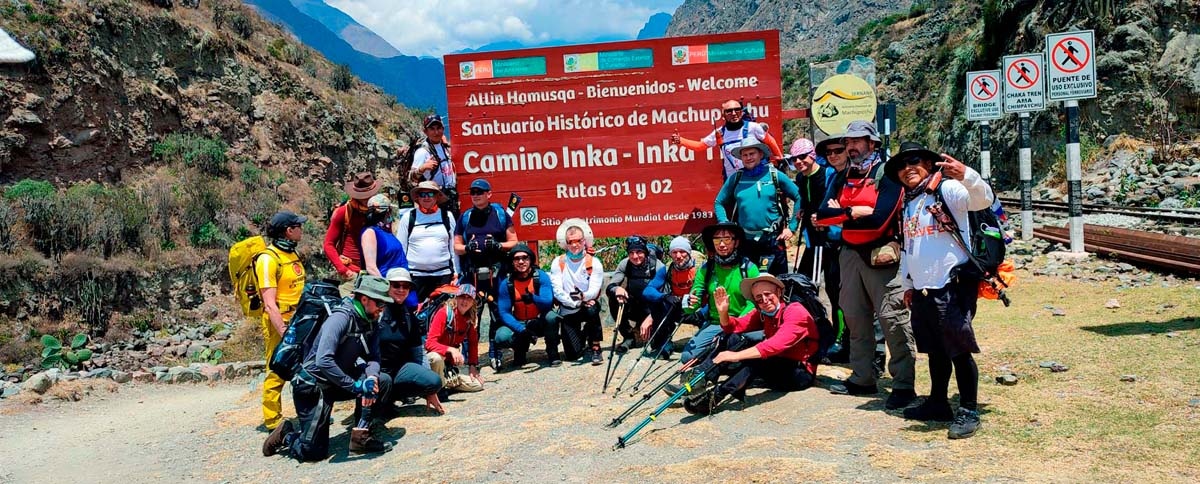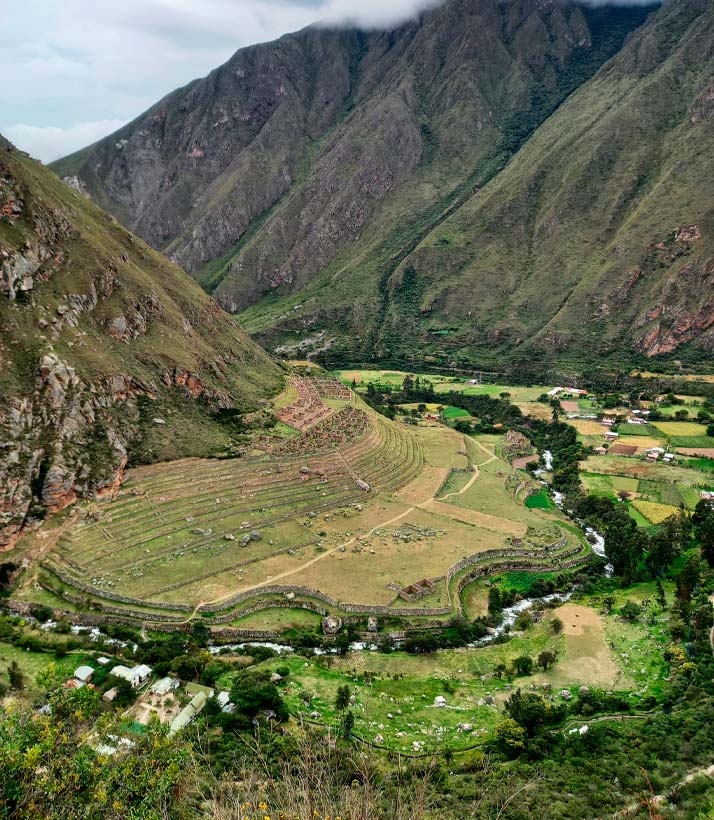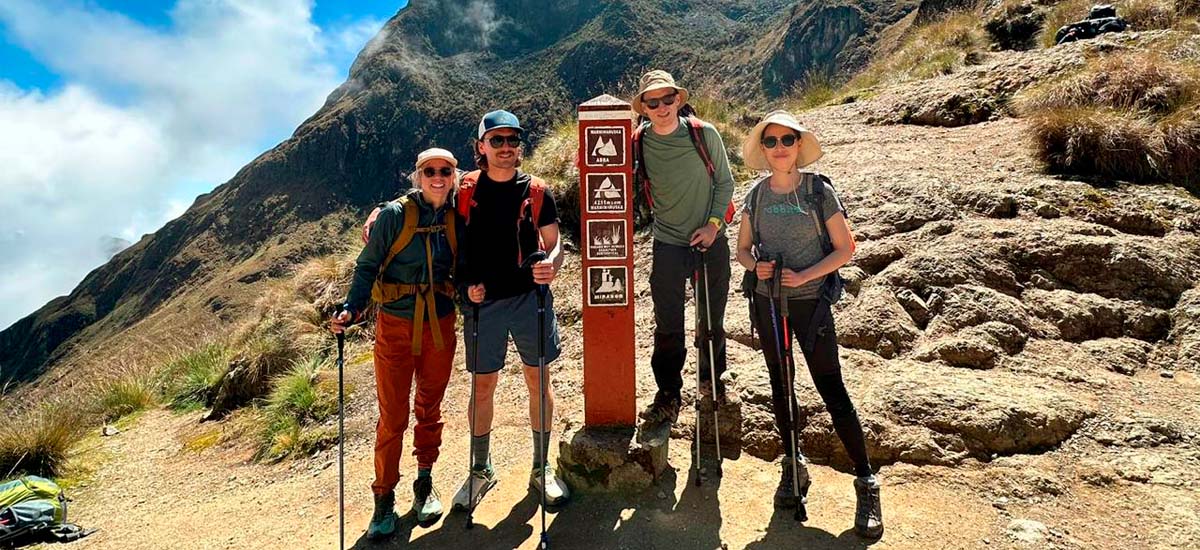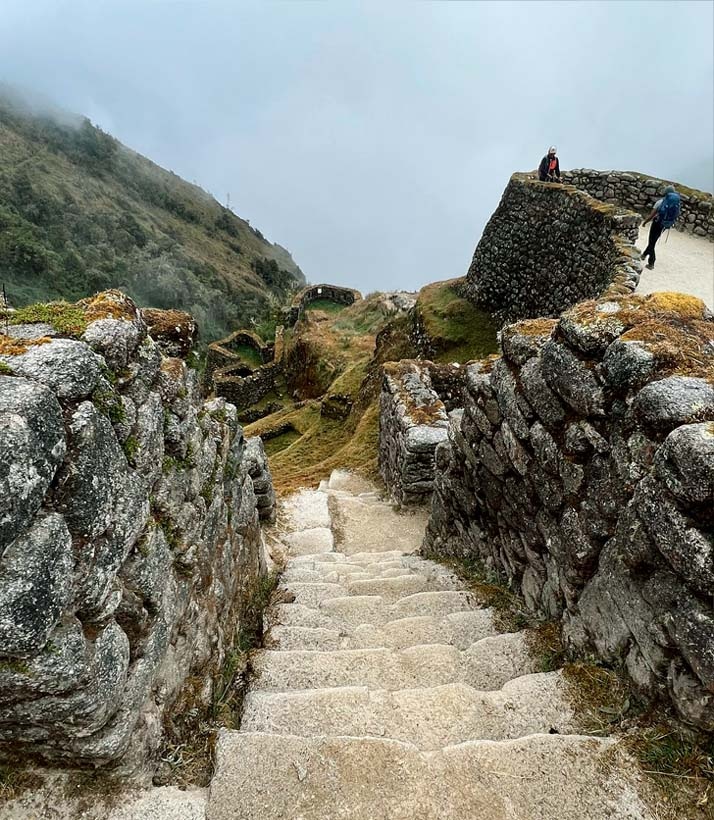
The Inca Trail is a high altitude hike that is usually completed over 4 days, and ends with a visit to the magnificent ruins of Machu Picchu. Here is what to expect each day on the trek, as well as seasonal differences and what the actual path looks like along the Inca Trail.
The 4 – Day Inca Trail to Machu Picchu is a spectacular high altitude trek in the Peruvian Andes that starts in Cusco and ends at the famous ruins of Machu Picchu.
The Inca Trail is by far the most well known and famouse trek in Peru. It’s a truly memorable experience in a dramatic and beautiful corner of the Andes. Moreover, you get to see and explore various Inca ruins throughout the trek and learn about the region’s rich cultural heritage.
The Machu Picchu Historical Sanctuary is a UNESCO World Heritage site for both culture and nature!
In fact, the Inca Trail’s natural wonders and incredible architectural ruins make it one of only 39 sites globally to be a UNESCO World Heritage site for both nature and culture!
The Inca Trail is a challenging up and down route, as the elevation map below shows.
But nobody does it alone; everyone trekking the Inca Trail travels with a tour operator, and your guides are there to encourage and look after you. The group dynamic is also a wonderful part of the experience.
The Inca Trail sits within the 32,000 hectares (79,070 acres) of the Machu Picchu Historic Sanctuary.
Trekkers of the Inca Trail hike through beautiful cloud forest as well as high altitude grassland known as Puna.
The cloud forest covers this part of the Andes between around 2,400 to 3,500 m (7,900 to 11,500 ft). The vegetation is thick and tangled, and boasts incredible biodiversity. You can look forward to seeing the likes of ferns, orchids, bromeliads and mosses.
The Inca Trail’s cloud forest is as its name suggests – often shrouded in mist.
Once you climb above 3,500 m (11,500 ft), you enter a harsh mountain environment where hardy grasses, mosses and lichens grow. The views from this high up are just incredible!
Throughout the trek, be sure to keep your eyes open for the animals and birds of the Inca Trail. These include llamas, Andean deer, Andean condors, hummingbirds and more!
The conditions on the Inca Trail vary depending on the season. There are two main seasons to note: the wet season and the drier season.
November to March is the wet season on the Inca Trail, and April to October is the drier season.
You probably noticed that we say ‘drier season’ and not ‘dry season’, because the region sees clouds and rain all year round. In fact, you should expect cloud and mist to be part of your Inca Trail experience, no matter what time of year you trek.
Also, you should note that Machu Picchu is often shrouded in mist first thing in the morning. Fortunately, this usually clears after a little while to let you enjoy panoramic views of the ruins and the surrounding valleys and peaks.
More information on when to hike the Inca Trai here!
During the trek you can expect to walk along:
****Trekking poles are really useful on the Inca Trail. But please note that you are not allowed to use poles with sharp metal tips (unless you cover them with bungs). This rule exists to protect the integrity of the historic stones as well as the mountain’s fragile ecosystems.
Let’s now discuss what you can expect each day on the Classic Inca Trail if you do it over four days.

In the morning you’re driven from Cusco to the start of the Inca Trail in the Urubamba Valley, where the adventure begins!
On this first day of trekking you pass through some rural villages and farms, and cross a few streams. You walk in forest and, excitingly, you encounter a few Inca ruins straight away! For instance, there’s Qanabamba, which was a created as a resting place for travellers, and the impressive ruins of the hill fort Huillca Raccay (also spelled Willkaraqay).
The highlight, however, is the sprawling, crescent-shaped ruins of Llactapata (also spelled Patallacta). The settlement is thought to have been abandoned around 1540. It has 116 buildings and five baths, plus a canal channelling water to the baths.
Today’s trek is relatively easy compared with those of Days 2 and 3. There are some ups and downs, but nothing extreme. That said, depending on how long you spent acclimatising before starting the trek, you may find exercising at this high altitude quite challenging.
Tonight you camp near the pretty village of Huayllabamba, which has the Río Llulluchayoc running through it. This is the largest settlement on the trail, and the last place where you can buy some basic supplies.
Highlight: Crossing Dead Woman’s Pass (4,215 m / 13,829 ft)
Things get serious today, as you must climb 1.5 km in elevation to cross Dead Woman’s Pass! While the approach looks gentle enough at points, it’s long and harder than it looks, and so you need to dig deep.
Known abroad as Dead Woman’s Pass, this high point on the Inca Trail is locally called Abra de Huarmihuanusca (or Warmiwanusca in Quechua). It’s also sometimes called First Pass, simply because it’s the first of the three passes that you cross on the Classic Inca Trail.
Note that once you’ve summited Dead Woman’s Pass, your work isn’t done! You now have a very long and steep descent ahead of you. In fact, you drop down 500 metres or so in the space of just two kilometres! The steps are large and often rocky and uneven, making those trekking poles we mentioned earlier an invaluable asset.
Much of today is spend trekking through high-altitude grassland. The views are expansive and absolutely breathtaking – they’re every bit what you came to the Andes hoping to find! There are jagged, snowcapped peaks all around.
For most of us, encountering a llama on the Inca Trail is a real bucket-list moment!
During the descent to your camp for the night you enter the beautiful, humid cloud forest. This variety of scenery and vegetation is a huge part of the Inca Trail’s appeal!
Tonight you camp at Pacamayo (or Paqaymayu in Quechua) in the heart of the Pacamayo Valley.


The trail today is another one of steep climbs and sharp descents. You cross two passes en route to the next campsite.
The first pass of the day – Runcu Raccay (or Runkurakay) – sits at 3,750 m or 12,335 ft above sea level and is sometimes simply called Second Pass on maps. Runcu Raccay pass is named for the ruins that sit here, which probably served as a storehouse for passing foot messengers during the days of the Inca Empire.
Later you cross Third Pass (or Phuyupatamarca), which is 3,650 m or 11,975 ft above sea level.
The various Inca ruins you encounter today are just next level amazing. And on top of that, you can look forward to walking through more beautiful cloud forest, where you should see orchids, hummingbirds and much more.
For many, Day 3 of the Inca Trail is their favourite day of the trek, as the scenery and ruins are both utterly incredible!
Visiting the ruins of Sayac Marca (or Sayakmarka) is one of the undisputed highlights of the day. In fact, they’re arguably the most beautiful Inca remains on the entire Inca Trail. Their name means ‘inaccessible town’, and refers to the fact that the compound sits on a ledge that pokes out of the mountainside high above the valley floor.
You overnight alongside the Inca ruins of Wiñaywayna (also spelled Wiñayhuayna). There are cold showers on offer here for a small fee.
Wiñaywayna (whose name means ‘forever young’) clings to a steep slope and it is simply astonishing. At the centre is the compound, and then on all sides are many terraces still in amazing condition.
The terraces at Wiñaywayna showcase the Incas’ amazing ability to grow crops in even the most challenging mountain environments.
If, however, the campsite at Wiñaywayna is too full, you must head to Phuyupatamarca (3,680 m / 12,073 ft) for the night. This campsite – whose name means ‘town in the clouds’ – offers an incredible view of the surrounding mountains!
The final day of the Inca Trail is a relatively short one. But utterly memorable!
Trekkers usually wake up and set out predawn in the hopes of reaching the fabulous lookout point offered by the ruins of Sun Gate (Intipunku) around sunrise. Sun Gate was an Inca fortress and its positioning affords trekkers their first iconic view down towards Machu Picchu.
But be warned: the climb up to Sun Gate is taxing and involves some massively big steps!
The Inca Trail ends with you entering Machu Picchu and exploring these incredible ruins. The stone masonry skills of the Incas and the scale of their undertakings is truly astounding, and inspires awe to this day. As noted in The Architects’ Take:
❝ The Inca people of the Andes had a special relationship with rock. Stone informed their entire culture, and was key to their empire-building success. ❞
After visiting Machu Picchu, you enjoy lunch at the on site restaurant if you’re doing the trip with Orange Nation Peru. Afterwards, you’re driven down to Machu Picchu Town (also often referred to as Aguas Calientes), where you could also enjoy lunch if you haven’t already.
Later in the afternoon you enjoy a scenic 4 hour train ride back to Cusco for the night.
So are you inspired to trek the Inca Trail to Machu Picchu? If so, please give us a shout. Those of you who know us at Follow Alice know that high-altitude trekking is our thing, and we’d love to help you make this adventure a reality!